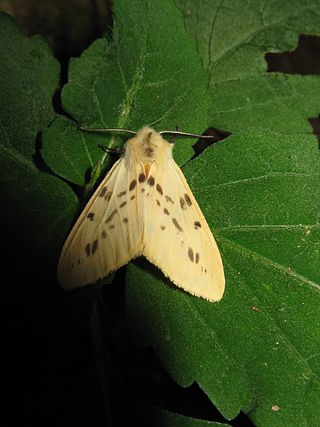
Achlya flavicornis, the yellow horned, is a moth of the family Drepanidae. The species was first described by Carl Linnaeus in his 1758 10th edition of Systema Naturae. It is found from Europe to the eastern Palearctic ecozone.

Lemyra is a genus of tiger moths in the family Erebidae. The genus contains many species from East and South Asia, Sundaland and Australia. It was described by Francis Walker in 1856.
Lemyra maculifascia is a moth of the family Erebidae. It was described by Francis Walker in 1855. It is found in China, Indonesia, Timor, the Philippines, New Guinea and Australia. It is found in secondary habitats, including bush, clearings in primary forests and plantations, from the sea level up to elevations of about 1,200 meters.
Lemyra flammeola is a moth of the family Erebidae. It was described by Frederic Moore in 1877. It is found in China.
Lemyra flavalis is a moth of the family Erebidae. It was described by Frederic Moore in 1865. It is found in China, Nepal, India, Bhutan and Myanmar.
Lemyra flaveola is a moth of the family Erebidae. It was described by John Henry Leech in 1899. It is found in western China.
Lemyra heringi is a moth of the family Erebidae. It was described by Franz Daniel in 1943. It is found in Yunnan, China.
Lemyra hyalina is a moth of the family Erebidae. It was described by Cheng-Lai Fang in 1990. It is found in China in Guangxi and Guangdong.

Lemyra imparilis is a moth of the family Erebidae. It was described by Arthur Gardiner Butler in 1877. It is found in China, Taiwan, Japan and Korea.
Lemyra melanosoma is a moth of the family Erebidae. It was described by George Hampson in 1894. It is found in China, Pakistan, eastern India, Myanmar and Thailand.
Lemyra melli is a moth of the family Erebidae. It was described by Franz Daniel in 1943. It is found in China.

Lemyra multivittata is a moth of the family Erebidae. It was described by Frederic Moore in 1865. It is found in Nepal, India, Myanmar and China.
Lemyra neglecta is a moth of the family Erebidae. It was described by Walter Rothschild in 1910. It is found in India, Nepal, Myanmar and China.
Lemyra phasma is a moth of the family Erebidae. It was described by John Henry Leech in 1899. It is found in China and possibly northern Vietnam.
Lemyra proteus is a moth of the family Erebidae. It was described by Joseph de Joannis in 1928. It is found in China and Vietnam.
Lemyra rhodophila is a moth of the family Erebidae. It was described by Francis Walker in 1864. It is found in China (Tibet), Pakistan, India, Myanmar and Nepal.
Lemyra rubidorsa is a moth of the family Erebidae. It was described by Frederic Moore in 1865. It is found in Pakistan (Kashmir), India and China.
Lemyra rubrocollaris is a moth of the family Erebidae. It was described by Reich in 1937. It is found in China (Jiangsu).

Lemyra stigmata is a moth of the family Erebidae. It was described by Frederic Moore in 1865. It is found in China, Pakistan, India, Nepal, Bhutan, Myanmar, Thailand and Vietnam.
Epipsestis ornata is a moth in the family Drepanidae. It was described by John Henry Leech in 1889. It is found in Japan, the Korean Peninsula, the Russian Far East and the Chinese provinces of Heilongjiang, Jilin and Shaanxi.




